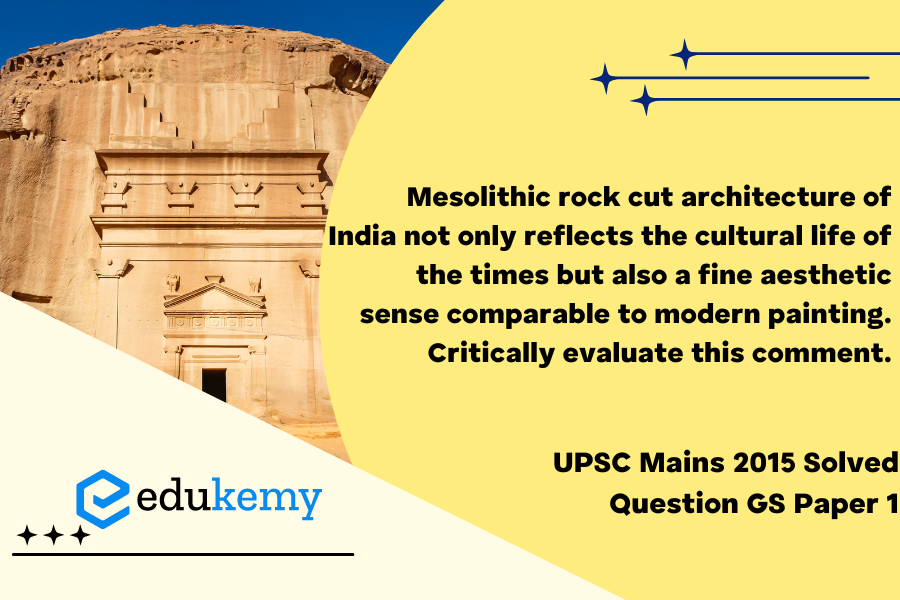The Mesolithic rock-cut architecture of India stands as a testament to the cultural vibrancy and sophisticated aesthetic sensibilities of its ancient inhabitants. Dating back to a period roughly between 10,000 and 2,500 BCE, these rock-cut structures reveal a fascinating glimpse into the lives of prehistoric communities. Characterized by intricate carvings, these architectural marvels served not only as shelters but also as canvases depicting the societal nuances, rituals, and daily life of their creators. The comment suggesting a fine aesthetic sense comparable to modern painting is indeed noteworthy. The intricate detailing and artistic finesse exhibited in these rock-cut structures demonstrate a level of craftsmanship that transcends mere utilitarian purposes. The creators, driven by a deep connection to their environment and spiritual beliefs, translated their cultural ethos onto the rock surfaces with a mastery that echoes the sophistication of contemporary artistic expressions.
However, a critical evaluation is essential. While the comparison to modern painting highlights the artistic merit, it also risks oversimplification. The Mesolithic rock-cut architecture, rooted in a vastly different context, serves multiple functions beyond artistic expression. It functions as a repository of cultural narratives, offering insights into the societal structure, religious practices, and technological advancements of the time. Thus, while acknowledging the aesthetic parallels, one must recognize the multifaceted nature of these structures, encompassing both utilitarian and symbolic dimensions. In conclusion, the Mesolithic rock-cut architecture of India indeed reflects a fine aesthetic sense, but its comprehensive evaluation demands an appreciation of its diverse roles and the unique cultural tapestry it encapsulates.
Tag: Indian Culture.
Contents
Decoding the question:
- In the Introduction, try to start with the period of the Mesolithic age.
- In Body, discuss how rock-cut architecture of the Mesolithic age reflected both cultural and aesthetic sense with their features.
- Conclude with the comparison to the modern paintings concerning the aesthetic sense.
Answer:
The Mesolithic Age is the period between the end of the Palaeolithic Age and the Neolithic Age. The Mesolithic Age in India lies roughly between 10,000 – 2,000 BCE. The art and architecture conceived during this period are referred to as Mesolithic art.
The art of the era was primarily concerned with how men lived, whereas the classical arts mostly depicted what men observed, and modern art primarily depicted what men thought. Because the early art forms were closer to nature, they had a strong aesthetic sense, which appealed to the majority of people in comparison to Modern Art.

Some of the Mesolithic sites in India are situated in Uttar Pradesh (e.gSarai Nahar Rai, Morhana Pahar), Madhya Pradesh (Bhimbetka), Rajasthan (Bagor), Gujarat (Alhaj, Valsana), Odisha, Tamil Nadu, and Andhra Pradesh.
Some features of this era are:
- The primary characteristic of Mesolithic rock-cut architecture is rock cave paintings, which in some ways reflected daily life during that period, as the majority of the paintings depicted animals, hunting scenes, and so forth.
- Mesolithic sites also featured paintings depicting social life, sexual activity, childbirth, child-rearing, and funeral ceremonies.
- Mesolithic man has an artistic sensibility, as the majority of the artwork reflected the natural world surrounding the men.
- Rock art is in the form of petroglyphs (rock paintings) and petroglyphs (rock engravings) of which Bhimbetka is a classic example. The art in these natural cave shelters depicts the social life in those times especially related to hunting, sexual activities, childbirth, burial, etc.
- People in this age had, thus developed a clear aesthetic sense as most of the paintings portrayed the nature around them.
Comparison to the modern paintings:
- While early modern paintings were artificial and grandiose, they lacked aesthetic sense, since they were encouraged by British rulers and dominated by materialist themes, while nature was largely ignored, as in bazaar and company school paintings.
- However, in the late nineteenth century, many modern painters such as Raja Ravi Verma, and Amrita Shergill, and painters of the Bengal School such as Nandlal Bose and Abanindranath Tagore reflected the cultural times of the era and had a fine aesthetic sense similar to Mesolithic paintings, as nature was depicted with utmost realism in their paintings, an example being Abanindranath Tagore’s famous Bharatmata painting.
- Even M.F. Hussein’s contemporary Indian paintings exhibit a refined aesthetic sense, as they are largely based on European neo-classical traditions.
- Whereas abstract modern art eschews the proportions and aesthetics of classical and Stone Age art and appeals to a narrow segment of the population.
Even contemporary Indian paintings of today exhibit a fine aesthetic sense, as they are mostly based on European neo-classical traditions. Whereas abstract modern art incidentally lacks the aesthetics of classical and Stone Age art and appeals to only a selected class of people.
To get free counseling/support on UPSC preparation from expert mentors please call 9773890604
- Join our Main Telegram Channel and access PYQs, Current Affairs and UPSC Guidance for free – Edukemy for IAS
- Learn Economy for free- Economy for UPSC
- Mains Answer Writing Practice-Mains Answer Writing
- For UPSC Prelims Resources, Click here


